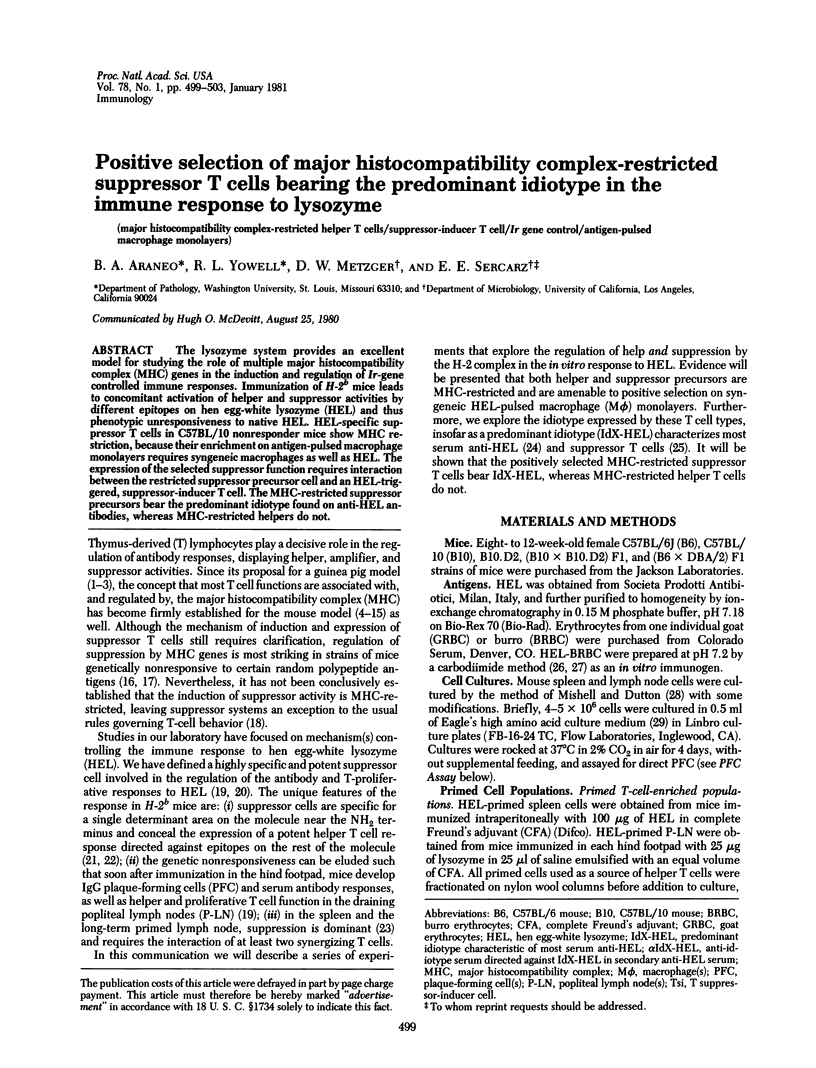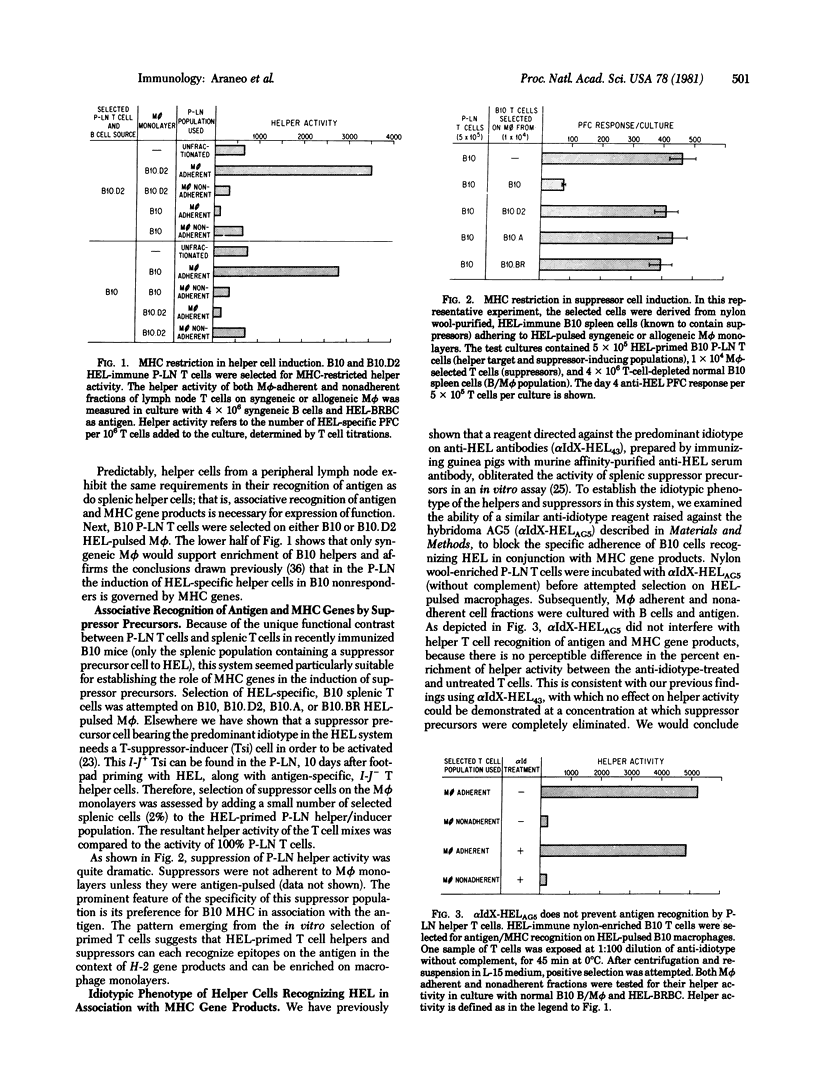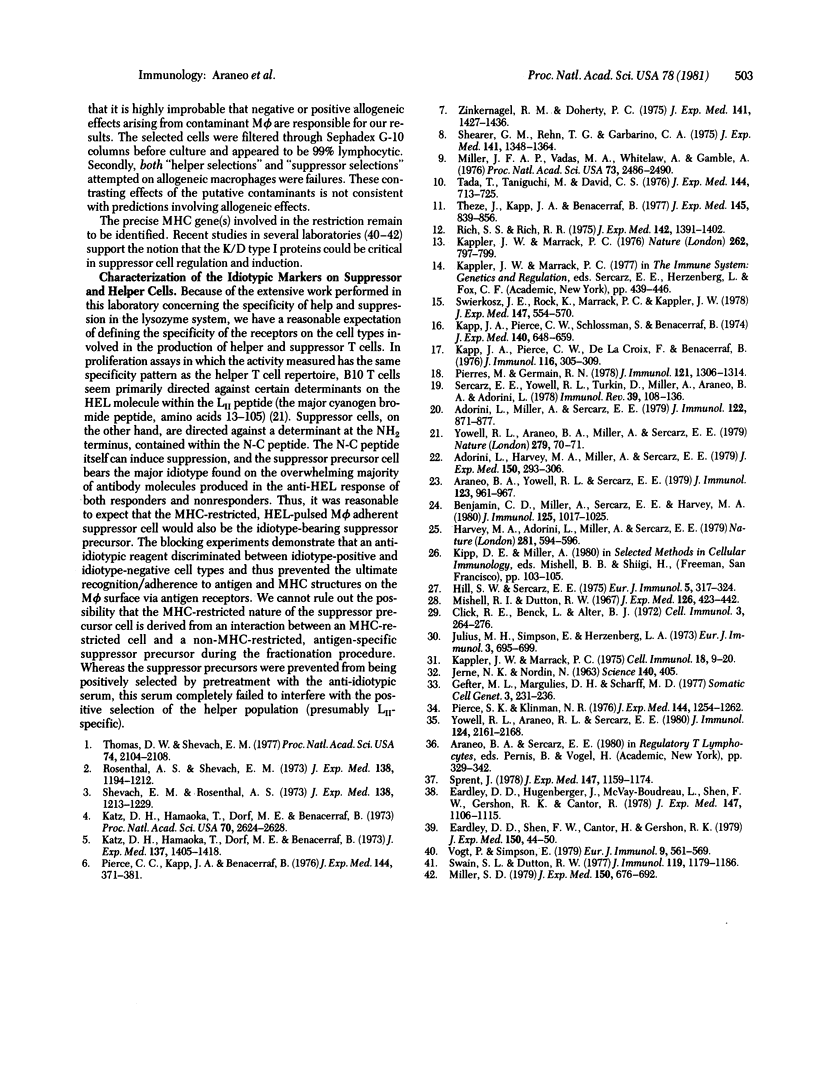Abstract
The lysozyme system provides an excellent model for studying the role of multiple major histocompatibility complex (MHC) genes in the induction and regulation of Ir-gene controlled immune responses. Immunization of H-2b mice leads to concomitant activation of helper and suppressor activities by different epitopes on hen egg-white lysozyme (HEL) and thus phenotype unresponsiveness to native HEL. HEL-specific suppressor T cells in C57BL/10 nonresponder mice show MHC restriction, because their enrichment on antigen-pulsed macrophage monolayers requires syngeneic macrophages as well as HEL. The expression of the selected suppressor function requires interaction between the restricted suppressor precursor cell and an HEL-triggered, suppressor-inducer T cell. The MHC-restricted suppressor precursors bear the predominant idiotype found on anti-HEL antibodies, whereas MHC-restricted helpers do not.
Full text
PDF




Selected References
These references are in PubMed. This may not be the complete list of references from this article.
- Adorini L., Harvey M. A., Miller A., Sercarz E. E. Fine specificity of regulatory T cells. II. Suppressor and helper T cells are induced by different regions of hen egg-white lysozyme in a genetically nonresponder mouse strain. J Exp Med. 1979 Aug 1;150(2):293–306. doi: 10.1084/jem.150.2.293. [DOI] [PMC free article] [PubMed] [Google Scholar]
- Adorini L., Miller A., Sercarz E. E. The fine specificity of regulatory T cells. I. Hen egg-white lysozyme-induced suppressor T cells in a genetically nonresponder mouse strain do not recognize a closely related immunogenic lysozyme. J Immunol. 1979 Mar;122(3):871–877. [PubMed] [Google Scholar]
- Araneo B. A., Yowell R. L., Sercarz E. E. Ir gene defects may reflect a regulatory imbalance. I. Helper T cell activity revealed in a strain whose lack of response is controlled by suppression. J Immunol. 1979 Sep;123(3):961–967. [PubMed] [Google Scholar]
- Benjamin C. D., Miller A., Sercarz E. E., Harvey M. A. A predominant idiotype on anti-hen egg white lysozyme antibodies from diverse mouses strains. J Immunol. 1980 Sep;125(3):1017–1025. [PubMed] [Google Scholar]
- Click R. E., Benck L., Alter B. J. Immune responses in vitro. I. Culture conditions for antibody synthesis. Cell Immunol. 1972 Feb;3(2):264–276. doi: 10.1016/0008-8749(72)90165-7. [DOI] [PubMed] [Google Scholar]
- Eardley D. D., Hugenberger J., McVay-Boudreau L., Shen F. W., Gershon R. K., Cantor H. Immunoregulatory circuits among T-cell sets. I. T-helper cells induce other T-cell sets to exert feedback inhibition. J Exp Med. 1978 Apr 1;147(4):1106–1115. doi: 10.1084/jem.147.4.1106. [DOI] [PMC free article] [PubMed] [Google Scholar]
- Eardley D. D., Shen F. W., Cantor H., Gershon R. K. Genetic control of immunoregulatory circuits. Genes linked to the Ig locus govern communication between regulatory T-cell sets. J Exp Med. 1979 Jul 1;150(1):44–50. doi: 10.1084/jem.150.1.44. [DOI] [PMC free article] [PubMed] [Google Scholar]
- Gefter M. L., Margulies D. H., Scharff M. D. A simple method for polyethylene glycol-promoted hybridization of mouse myeloma cells. Somatic Cell Genet. 1977 Mar;3(2):231–236. doi: 10.1007/BF01551818. [DOI] [PubMed] [Google Scholar]
- Harvey M. A., Adorini L., Miller A., Sercarz E. E. Lysozyme-induced T-suppressor cells and antibodies have a predominant idiotype. Nature. 1979 Oct 18;281(5732):594–596. doi: 10.1038/281594a0. [DOI] [PubMed] [Google Scholar]
- Hill S. W., Sercarz E. E. Fine specificity of the H-2 linked immune response gene for the gallinaceous lysozymes. Eur J Immunol. 1975 May;5(5):317–324. doi: 10.1002/eji.1830050506. [DOI] [PubMed] [Google Scholar]
- Kapp J. A., Pierce C. W., De la Croix F., Benacerraf B. Immunosuppressive factor(s) extracted from lymphoid cells of nonresponder mice primed with L-glutamic acid60-L-alanine30-L-tyrosine10 (GAT). J Immunol. 1976 Feb;116(2):305–309. [PubMed] [Google Scholar]
- Kapp J. A., Pierce C. W., Schlossman S., Benacerraf B. Genetic control of immune responses in vitro. V. Stimulation of suppressor T cells in nonresponder mice by the terpolymer L-glutamic acid 60-L-alanine 30-L-tyrosine 10 (GAT). J Exp Med. 1974 Sep 1;140(3):648–659. doi: 10.1084/jem.140.3.648. [DOI] [PMC free article] [PubMed] [Google Scholar]
- Kappler J. W., Marrack P. C. Functional heterogeneity among the T-derived lymphocytes of the mouse. III. Helper and suppressor T-cells activated by concanavalin A. Cell Immunol. 1975 Jul;18(1):9–20. doi: 10.1016/0008-8749(75)90031-3. [DOI] [PubMed] [Google Scholar]
- Kappler J. W., Marrack P. C. Helper T cells recognise antigen and macrophage surface components simultaneously. Nature. 1976 Aug 26;262(5571):797–799. doi: 10.1038/262797a0. [DOI] [PubMed] [Google Scholar]
- Katz D. H., Hamaoka T., Benacerraf B. Cell interactions between histoincompatible T and B lymphocytes. II. Failure of physiologic cooperative interactions between T and B lymphocytes from allogeneic donor strains in humoral response to hapten-protein conjugates. J Exp Med. 1973 Jun 1;137(6):1405–1418. doi: 10.1084/jem.137.6.1405. [DOI] [PMC free article] [PubMed] [Google Scholar]
- Katz D. H., Hamaoka T., Dorf M. E., Benacerraf B. Cell interactions between histoincompatible T and B lymphocytes. The H-2 gene complex determines successful physiologic lymphocyte interactions. Proc Natl Acad Sci U S A. 1973 Sep;70(9):2624–2628. doi: 10.1073/pnas.70.9.2624. [DOI] [PMC free article] [PubMed] [Google Scholar]
- Miller J. F., Vadas M. A., Whitelaw A., Gamble J. Role of major histocompatibility complex gene products in delayed-type hypersensitivity. Proc Natl Acad Sci U S A. 1976 Jul;73(7):2486–2490. doi: 10.1073/pnas.73.7.2486. [DOI] [PMC free article] [PubMed] [Google Scholar]
- Miller S. D. Suppressor T-cell mechanisms in contact sensitivity. III. Apparent non-major histocompatibility complex restriction is a result of multiple sets of major histocompatibility complex-specific suppressor T cells induced by syngeneic 2,4-dinitrophenyl-modified lymphoid cells. J Exp Med. 1979 Sep 19;150(3):676–692. doi: 10.1084/jem.150.3.676. [DOI] [PMC free article] [PubMed] [Google Scholar]
- Mishell R. I., Dutton R. W. Immunization of dissociated spleen cell cultures from normal mice. J Exp Med. 1967 Sep 1;126(3):423–442. doi: 10.1084/jem.126.3.423. [DOI] [PMC free article] [PubMed] [Google Scholar]
- Pierce C. W., Kapp J. A., Benacerraf B. Regulation by the H-2 gene complex of macrophage-lymphoid cell interactions in secondary antibody responses in vitro. J Exp Med. 1976 Aug 1;144(2):371–381. doi: 10.1084/jem.144.2.371. [DOI] [PMC free article] [PubMed] [Google Scholar]
- Pierce S. K., Klinman N. R. Allogeneic carrier-specific enhancement of hapten-specific secondary B-cell responses. J Exp Med. 1976 Nov 2;144(5):1254–1262. doi: 10.1084/jem.144.5.1254. [DOI] [PMC free article] [PubMed] [Google Scholar]
- Pierres M., Germain R. N. Antigen-specific T cell-mediated suppression. IV. Role of macrophages in generation of L-glutamic acid60-L-alanine30-L-tyrosine10 (GAT)-specific suppressor T cells in responder mouse strains. J Immunol. 1978 Oct;121(4):1306–1314. [PubMed] [Google Scholar]
- Rich S. S., Rich R. R. Regulatory mechanisms in cell-mediated immune responses. II. A genetically restricted suppressor of mixed lymphocyte reactions released by alloantigen-activated spleen cells. J Exp Med. 1975 Dec 1;142(6):1391–1402. doi: 10.1084/jem.142.6.1391. [DOI] [PMC free article] [PubMed] [Google Scholar]
- Rosenthal A. S., Shevach E. M. Function of macrophages in antigen recognition by guinea pig T lymphocytes. I. Requirement for histocompatible macrophages and lymphocytes. J Exp Med. 1973 Nov 1;138(5):1194–1212. doi: 10.1084/jem.138.5.1194. [DOI] [PMC free article] [PubMed] [Google Scholar]
- Sercarz E. E., Yowell R. L., Turkin D., Miller A., Araneo B. A., Adorini L. Different functional specificity repertoires for suppressor and helper T cells. Immunol Rev. 1978;39:108–136. doi: 10.1111/j.1600-065x.1978.tb00398.x. [DOI] [PubMed] [Google Scholar]
- Shearer G. M., Rehn T. G., Garbarino C. A. Cell-mediated lympholysis of trinitrophenyl-modified autologous lymphocytes. Effector cell specificity to modified cell surface components controlled by H-2K and H-2D serological regions of the murine major histocompatibility complex. J Exp Med. 1975 Jun 1;141(6):1348–1364. doi: 10.1084/jem.141.6.1348. [DOI] [PMC free article] [PubMed] [Google Scholar]
- Shevach E. M., Rosenthal A. S. Function of macrophages in antigen recognition by guinea pig T lymphocytes. II. Role of the macrophage in the regulation of genetic control of the immune response. J Exp Med. 1973 Nov 1;138(5):1213–1229. doi: 10.1084/jem.138.5.1213. [DOI] [PMC free article] [PubMed] [Google Scholar]
- Sprent J. Restricted helper function of F1 hybrid T cells positively selected to heterologous erythrocytes in irradiated parental strain mice. II. Evidence for restrictions affecting helper cell induction and T-B collaboration, both mapping to the K-end of the H-2 complex. J Exp Med. 1978 Apr 1;147(4):1159–1174. doi: 10.1084/jem.147.4.1159. [DOI] [PMC free article] [PubMed] [Google Scholar]
- Swain S. L., Dutton R. W. Negative allogeneic effects in vitro. II. Mapping of histocompatibility differences leading to allosuppression. J Immunol. 1977 Sep;119(3):1179–1186. [PubMed] [Google Scholar]
- Swierkosz J. E., Rock K., Marrack P., Kappler J. W. The role of H-2 linked genes in helper T-cell function. II. Isolation on antigen-pulsed macrophages of two separate populations of F1 helper T cells each specific for antigen and one set of parental H-2 products. J Exp Med. 1978 Feb 1;147(2):554–570. doi: 10.1084/jem.147.2.554. [DOI] [PMC free article] [PubMed] [Google Scholar]
- Tada T., Taniguchi M., David C. S. Properties of the antigen-specific suppressive T-cell factor in the regulation of antibody response of the mouse. IV. Special subregion assignment of the gene(s) that codes for the suppressive T-cell factor in the H-2 histocompatibility complex. J Exp Med. 1976 Sep 1;144(3):713–725. doi: 10.1084/jem.144.3.713. [DOI] [PMC free article] [PubMed] [Google Scholar]
- Theze J., Kapp J. A., Benacerraf B. Immunosuppressive factor(s) extracted from lymphoid cells of nonresponder mice primed with L-glutamic acid60-L-alanine30-L-tyrosine10 (GAT) III. Immunochemical properties of the GAT-specific suppressive factor. J Exp Med. 1977 Apr 1;145(4):839–856. doi: 10.1084/jem.145.4.839. [DOI] [PMC free article] [PubMed] [Google Scholar]
- Thomas D. W., Shevach E. M. Nature of the antigenic complex recognized by T lymphocytes: specific sensitization by antigens associated with allogeneic macrophages. Proc Natl Acad Sci U S A. 1977 May;74(5):2104–2108. doi: 10.1073/pnas.74.5.2104. [DOI] [PMC free article] [PubMed] [Google Scholar]
- Vogt P., Simpson E. In vitro evidence from anti-hapten antibody responses for T helper and suppressor cells directed against major histocompatibility antigens in the mouse. Participation of I region determinants in the induction of T helper cells. Eur J Immunol. 1979 Jul;9(7):561–569. doi: 10.1002/eji.1830090712. [DOI] [PubMed] [Google Scholar]
- Yowell R. L., Araneo B. A., Miller A., Sercarz E. E. Amputation of a suppressor determinant on lysozyme reveals underlying T-cell reactivity to other determinants. Nature. 1979 May 3;279(5708):70–71. doi: 10.1038/279070a0. [DOI] [PubMed] [Google Scholar]
- Yowell R. L., Araneo B. A., Sercarz E. E. The fundamental T cell proliferative repertoire in a nonresponder strain and its qualitative alteration by suppression. J Immunol. 1980 May;124(5):2162–2168. [PubMed] [Google Scholar]
- Zinkernagel R. M., Doherty P. C. H-2 compatability requirement for T-cell-mediated lysis of target cells infected with lymphocytic choriomeningitis virus. Different cytotoxic T-cell specificities are associated with structures coded for in H-2K or H-2D;. J Exp Med. 1975 Jun 1;141(6):1427–1436. doi: 10.1084/jem.141.6.1427. [DOI] [PMC free article] [PubMed] [Google Scholar]


